Saturday, 30 May 2020
High-Protein Breakfast: How To Make Fried Eggs In A Microwave (Recipe Video Inside)
from NDTV Food - Latest https://ift.tt/2AnSiM8
15 Minute EMOM

Get moving with this 15 minute EMOM from Under Armour trainer Saman Munir.
The post 15 Minute EMOM appeared first on Under Armour.
from Under Armour https://ift.tt/36GMVUl
Runner’s 20 Minute EMOM

Engage your lower body in this 20 minute EMOM workout led by pro runner Vincent Crisp.
The post Runner’s 20 Minute EMOM appeared first on Under Armour.
from Under Armour https://ift.tt/3gC2ukA
Summer Diet: Beat The Heat With This Quick Watermelon-Mint Drink (Recipe Inside)
from NDTV Food - Latest https://ift.tt/3cnMG1O
7 Easy Indian Paneer Snacks To Try At Home During Lockdown
from NDTV Food - Latest https://ift.tt/3dgSCuJ
Twinkle Khanna Had Her First 'Maa Ke Hath Ka Khana'
from NDTV Food - Latest https://ift.tt/3gzngkR
10 Delicious, Sugar-Free Indian Desserts You Can Make At Home
from NDTV Food - Latest https://ift.tt/2AnaBB7
Friday, 29 May 2020
5 Mango Smoothies You Just Can't Miss This Summer Season
from NDTV Food - Latest https://ift.tt/3euqrZp
5 Ends-of-the-Earth Jobs That Redefine Remote Work
The coronavirus pandemic has indefinitely altered what many once knew as the workplace. And aside from essential workers thankfully caring for the ill, keeping supply chains in motion, and maintaining public services, a whole lot of employees (still fortunate to be working) have been delegated to a brave new work status: remote.
Bringing office culture home has it benefits. Online Zoom meetings allow you to introduce your cats to your co-workers, or sport the mullet equivalent of workplace attire (business up top within camera view; pajama pants below). When employers aren’t monitoring productivity, the homebound activities resume: baking another experimental bread, streaming epic films, taking on new fitness regimens, or deciding not to get out of bed at all.
Remote work also has its pitfalls. Like isolation. Take comfort that it could be worse. You could be stuck on a remote island for six months. Or waking before dawn in driving wind and rain to hike up to a lookout to record the non-existent visibility. Perhaps your work life could be locked deep in Antarctica for a year, getting probed by medical researchers to observe your reaction to oxygen-deprived tasks at -58 degrees, looking ahead to four more months of darkness. On the other hand, if any of that sounds exciting, your career search may have just gotten easier. Here are five jobs in the most extreme environments on the earth. They can provide some therapeutic perspective on what it really means to “work remote.”
from Men's Journal https://ift.tt/3exX2NT
Dispatches Grand Canyon: A Journey Through the Bottom of the Earth
Embarking on a rafting journey through the Grand Canyon began by dialing a phone number that I received in an Instagram DM from a stranger. The message read, “Hey, I know this is out of left field, especially since we’ve never met and you have no idea who I am—and a little bit of short notice—but I’ve got an open spot on my boat to float through the Grand Canyon in three weeks.” I was intrigued to say the least, and a few days after asking friends about the messenger and the potential adventure, I decided it was worth making the call to investigate the opportunity further.

An hour into our conversation, having asked a multitude of questions and liking the answers and vibes I received, I “spontaneously” accepted the unique chance-invitation to join this private-guided rafting trip for nine nights. I didn’t know it yet, but I had made a great decision.

A few weeks later, I joined a group of 15 people (already nine days into their journey) dispersed among eight rafts with 10 days worth of supplies. Beginning at Phantom Ranch, the latter half of the journey with my seasoned, river-going friends allowed nine days to travel the remaining 192 miles through the Granite gorges and 70 rapids.
What rapids lay ahead, what adventures, lifestyle, community and living conditions I was in for—I didn’t have any knowledge. I felt a little like John Wesley Powell, the first to explore this region in 1869 and put it on the map, embarking on this foreign expedition. In a journal that was later published as the popular book “The Exploration of the Colorado River and Its Canyons,” Powell wrote, “What falls there are, we know not; what rocks beset the channel, we know not; what walls rise over the river, we know not… With some eagerness and some anxiety and some misgiving we enter the canyon below and are carried away by the swift water through walls which rise from its very edge.”
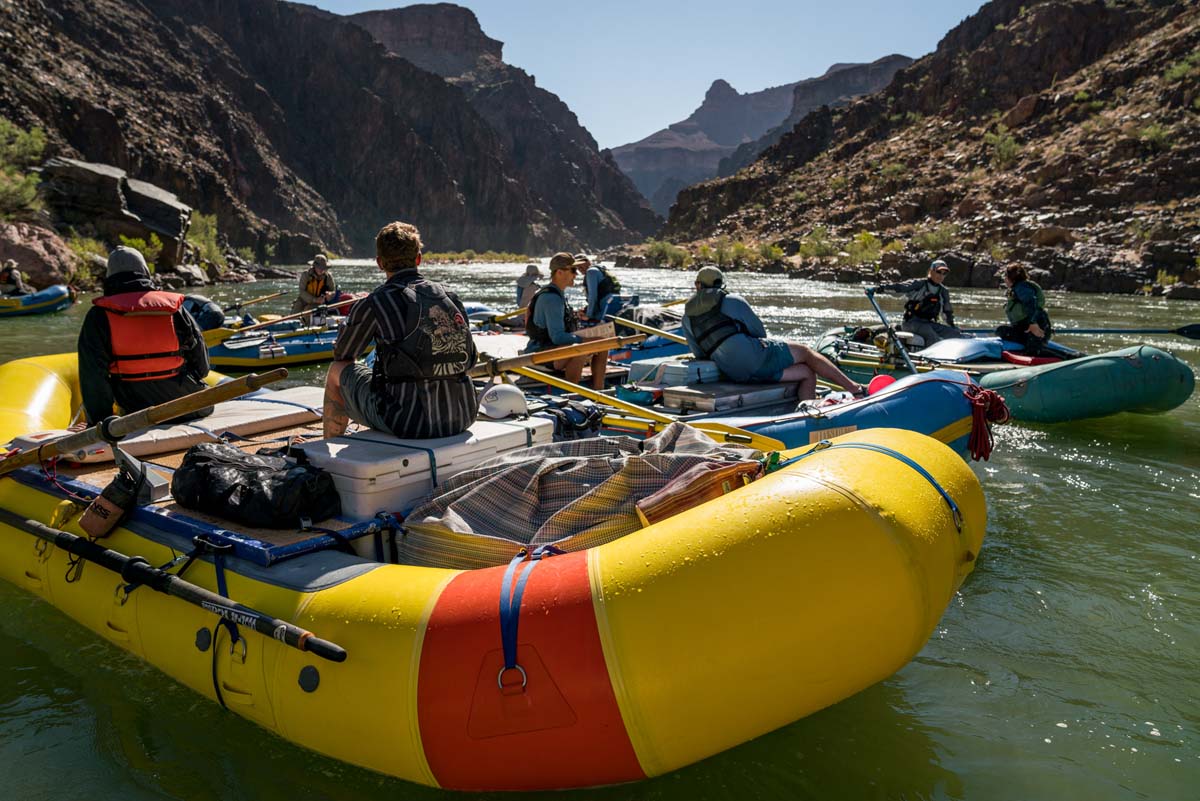
The Grand Canyon flows in an abundance of history, geology and adventure. Archaeologists believe that Native Americans inhabited the rim and canyon year-round beginning approximately 4,000 years ago. The first groups of people passing through the canyon and surrounding areas while hunting game and migrating during seasonal changes dates back to 10,000 years ago. The Havasupai tribe has been living in and around the Grand Canyon South Rim for the past 800 years, according to anthropologists. Today, the Havasupai and Hualapai Reservations are located on the South Rim of the Canyon. The Navajo Nation and Hopi Reservations are east of the Canyon.
Floating through the morphing walls and observing the different types of rocks present summoned fascination. The Grand Canyon is a world-renowned showplace of geology. There are nearly 40 major sedimentary rock layers exposed in the Grand Canyon, ranging in age from roughly 200-million to almost 2-billion years old. Fortunately, I shared a raft with a geology enthusiast, who bestowed me with knowledge and terminology. I chose Vishnu Schist as my favorite rock because it is one of the most ancient rock formations, at an unfathomable estimated 1.75 billion years old. It’s jet black and stunningly gorgeous. I kept thinking, “This Vishnu has seen so much.”

Within 30 minutes of joining the adventure at Phantom Ranch, the group let me know that I was in for a treat. We would be stopping to scout the first major rapid of the trip. They gave me a quick and thorough safety briefing.


Several times a day, we pulled the boats into an eddy up-river from major rapids and tied the bow line to trees on shore. We walked trails to lookout points to scout our lines for the rapids.
Everyone in the group goes to scout. It’s fascinating how they read the hydraulics of the water.

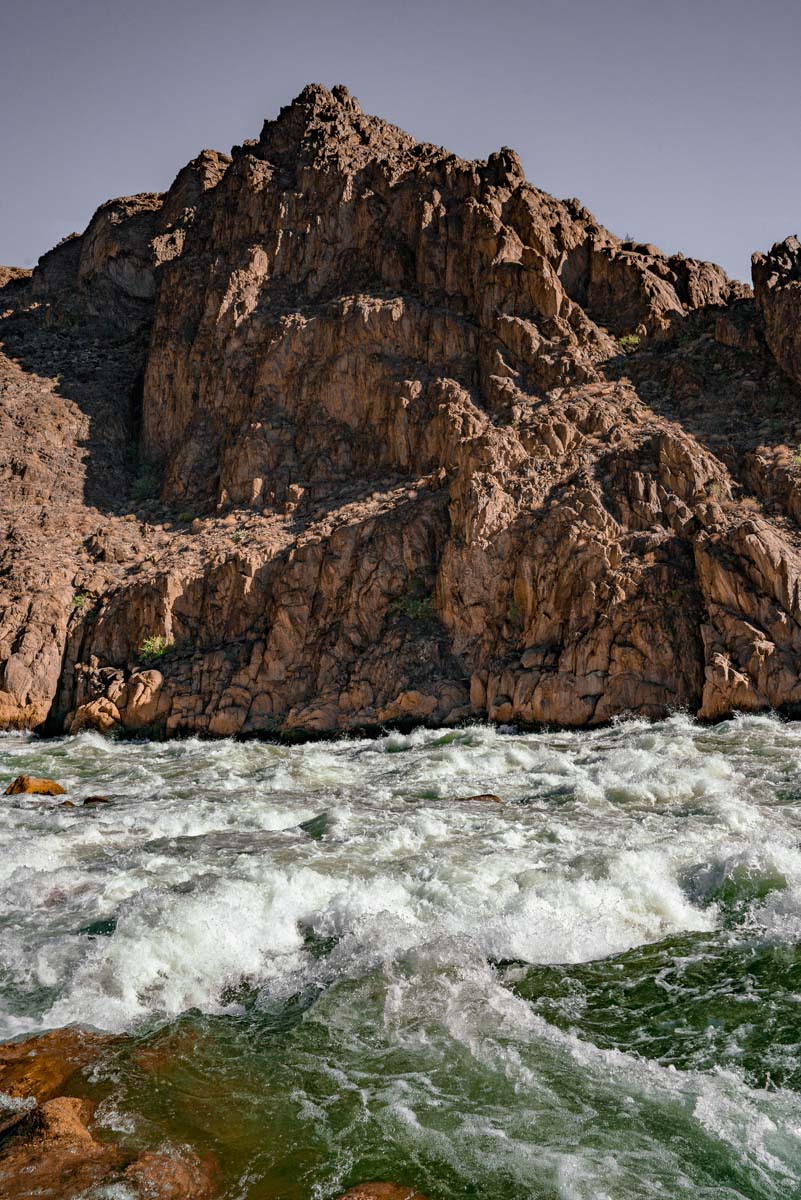

After safely passing through several class 3-7 rapids and conquering adequate river mileage, we stopped at a designated camp spot that served as home for the night. The stretch of the Colorado River that snakes through the Grand Canyon often uses a different rating system for rapids. The class 1-10 system that is used in the Grand Canyon roughly parallels Classes I-V on the International Scale of River Difficulty (ISRD). These categories, or “classes,” give rafters an idea of the skill level (novice to expert) needed to navigate a specific waterway.
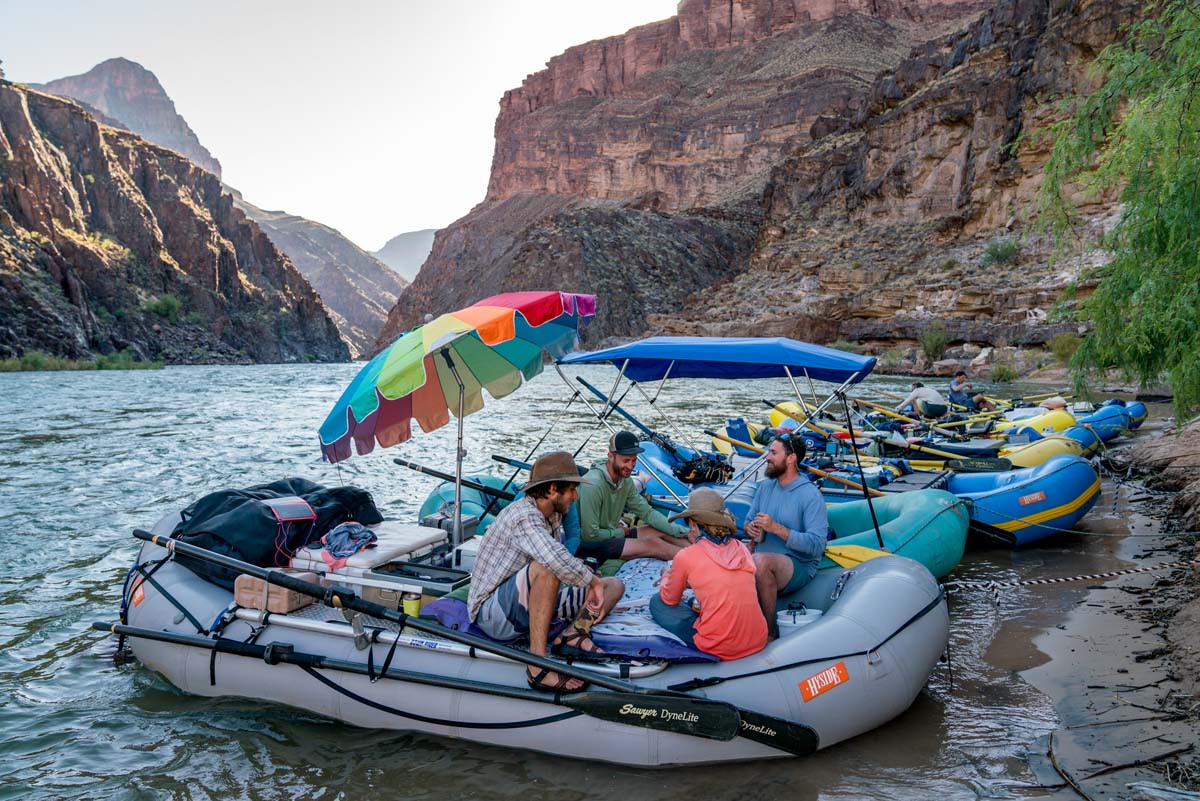
Each afternoon, we found a new site to spend the evening. Campsites dot the river banks of the Colorado most of the 277 miles of the canyon—however, not all are easily spotted or vacant.
The sun eventually ducks below the canyon wall ushering the shade. After a long day in the sun, big smiles and easy energy sweep across the group. Cards, mancala, chess and clever word games keep the group entertained once the boats are unloaded and the kitchen, garbage and groover (bathroom) are established. Work first, play second—and there is always plenty of time for both.


Others use this opportunity for alone time—to read a book, write or take to the frigid, yet beckoning waters of the Colorado to rinse away sand and sweat in an epic bath. The body quickly adapts to the cutting chill of the waters and eventually returns to them again and again, without notice of the cold but only to the relief they provide from sweltering temperatures.


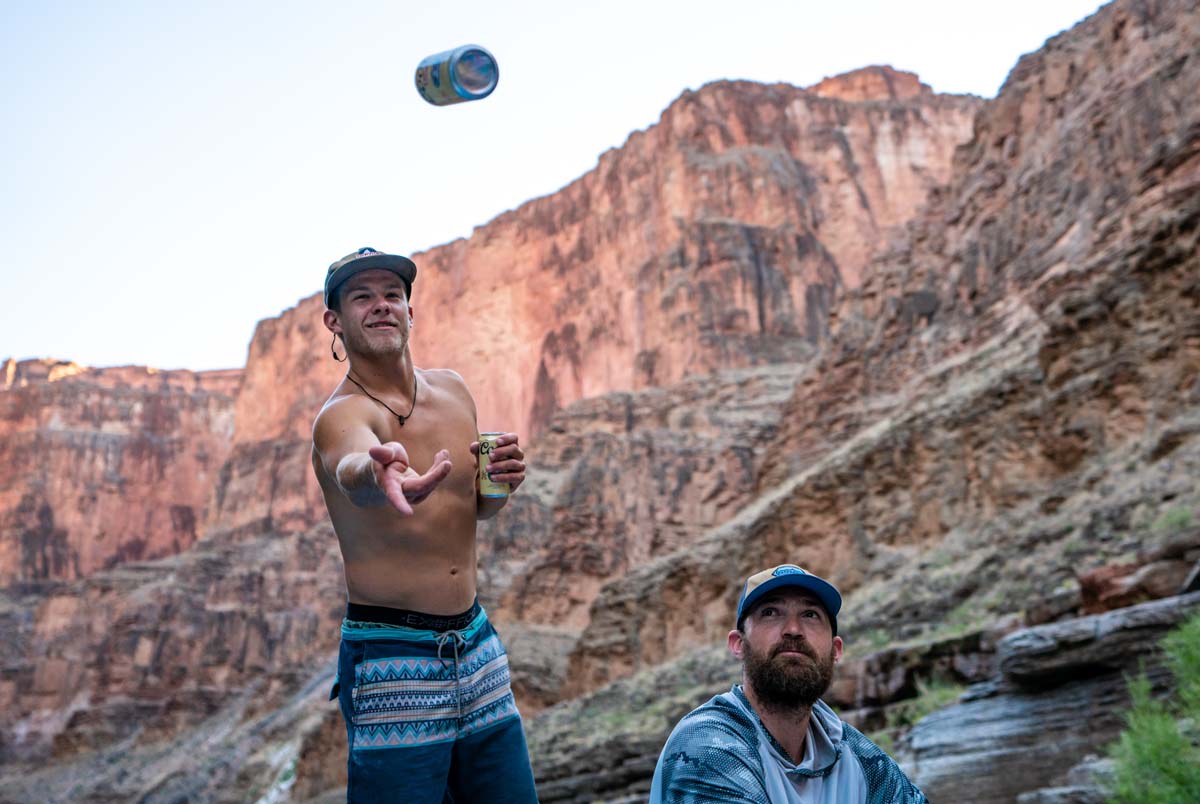


Every evening after river baths, we congregated in camping chairs to share a meal cooked by a team of raft-mates. Lizards watched from nearby rocks as stories, banter and laughter filled the space, and we gratefully chewed the prepared meal.
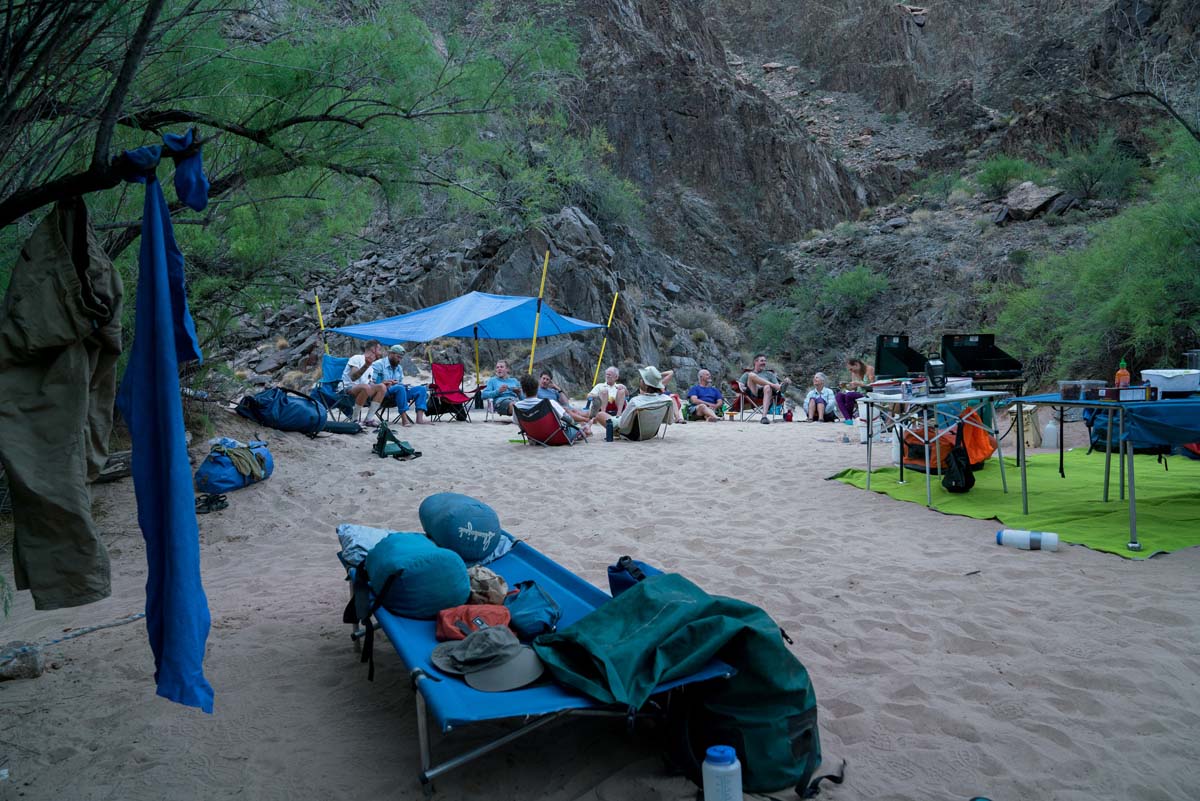

We cleaned our dishes in a line of four buckets of river water, two of which we heated over a flame and added either soap or bleach to sanitize. Then people pitched in to put away food, clean up the kitchen and strain the water from the buckets so the food particles would go into the garbage instead of the river. We all worked together every morning, afternoon and evening to ensure a tidy camp—employing the “Leave No Trace” methodology.

After long, fulfilling days, with energy reserves depleted, an early bedtime and the slightly cooler temperatures of dusk were welcomed. Some camped on cots on the beach, others slept on the rafts. Sleeping elevated from the ground is the best choice, so creepy crawlers (like scorpions, spiders and snakes) don’t get you while you rest. Nothing but the sounds of the water, wind and desert creatures remained once we retired.

In the summer, mornings come early. The sun rose around 5 a.m.—and the wake up call “COFFEE!” resounded around the camp at 5:30 a.m., followed by large steaming carafes to fill our early-bird mugs.

We were quick to make and eat a group breakfast, use the groover, practice personal hygiene, pack up the kitchen, secure belongings on our rafts, pump the rafts and make a clean sweep over camp.

To protect the pristine environment and reduce our impact, we all use the groover. It is said the name “Groover” came from the days prior to placing a plastic toilet seat on the Rocket Box. People would sit on the metal, rectangular-shaped Rocket Box and therefore when they finished their business, would be left with imprinted grooves on their back side.

The paddle system notified others if the groover was occupied. Paddle up meant the groover was vacant.
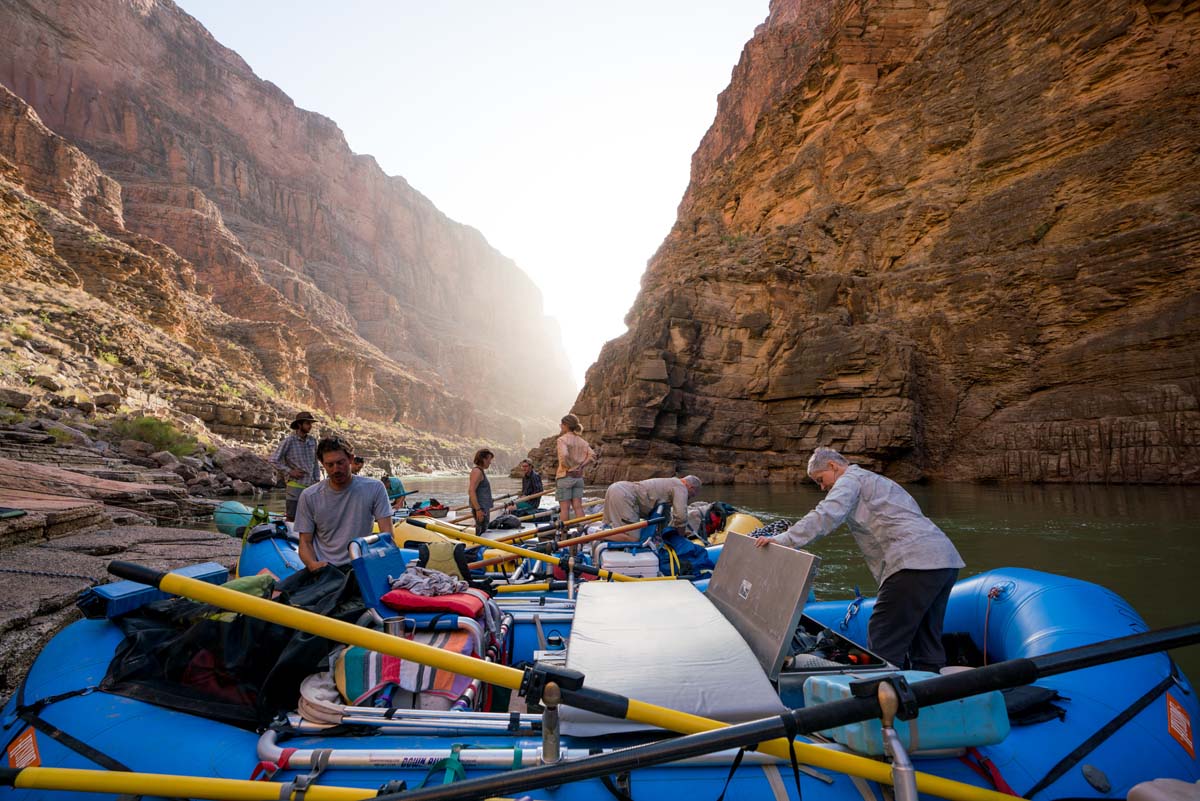

We typically headed out as a group around 7 a.m. every morning to begin making miles down the Colorado. Some days we made more miles than others. Shorter mileage days allowed time for epic side-hiking adventures to a variety of spectacular waterfalls, oases and slot canyons.

A three-mile hike to a waterfall began early, as we attempted to beat the heat before reaching a little oasis in the sky. We ascended thousands of feet on rocky switchbacks and very exposed cliffside trails. The heat came quickly and radiated from the rock walls, baking us like a convection oven.
We consumed all of our water with the knowledge that we could soon refill our bottles onsite at the waterfall.
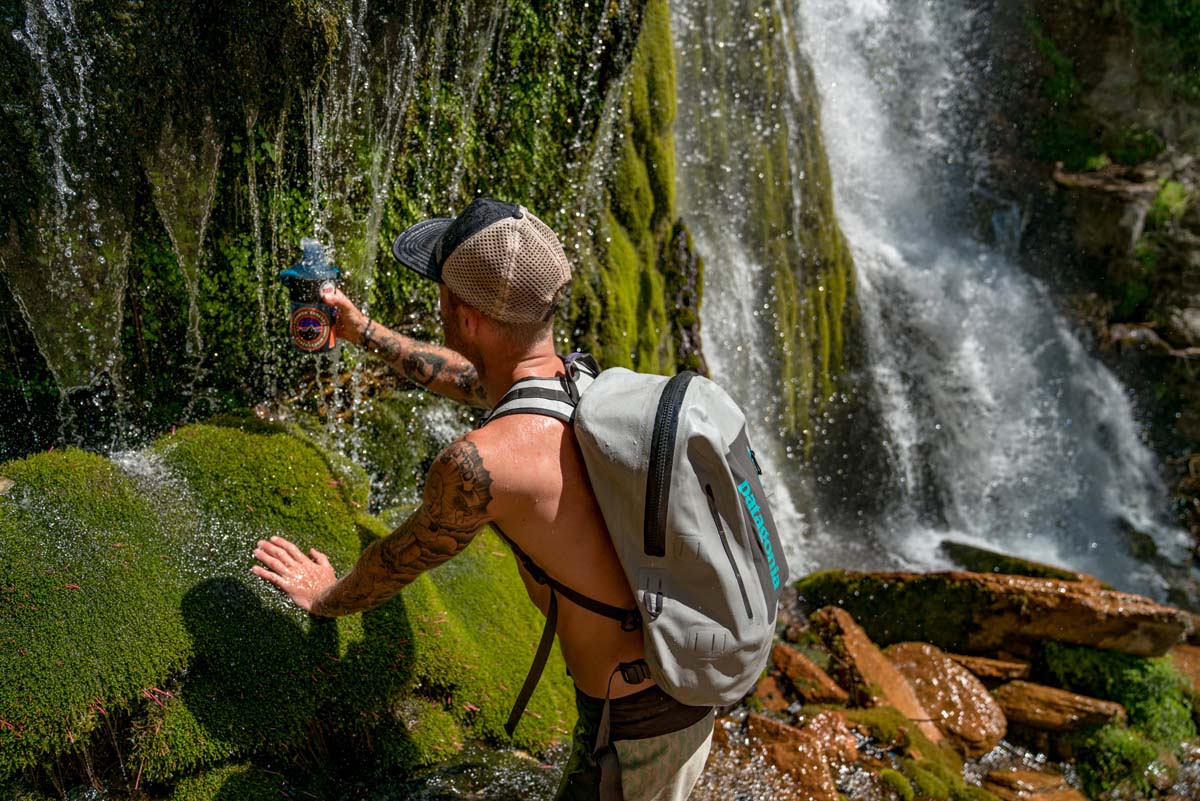

The spring served “all you can drink,” cold-as-ice water. Oh, and mint plants grew wild here. We infused our water bottles with the herb; it was paradise.
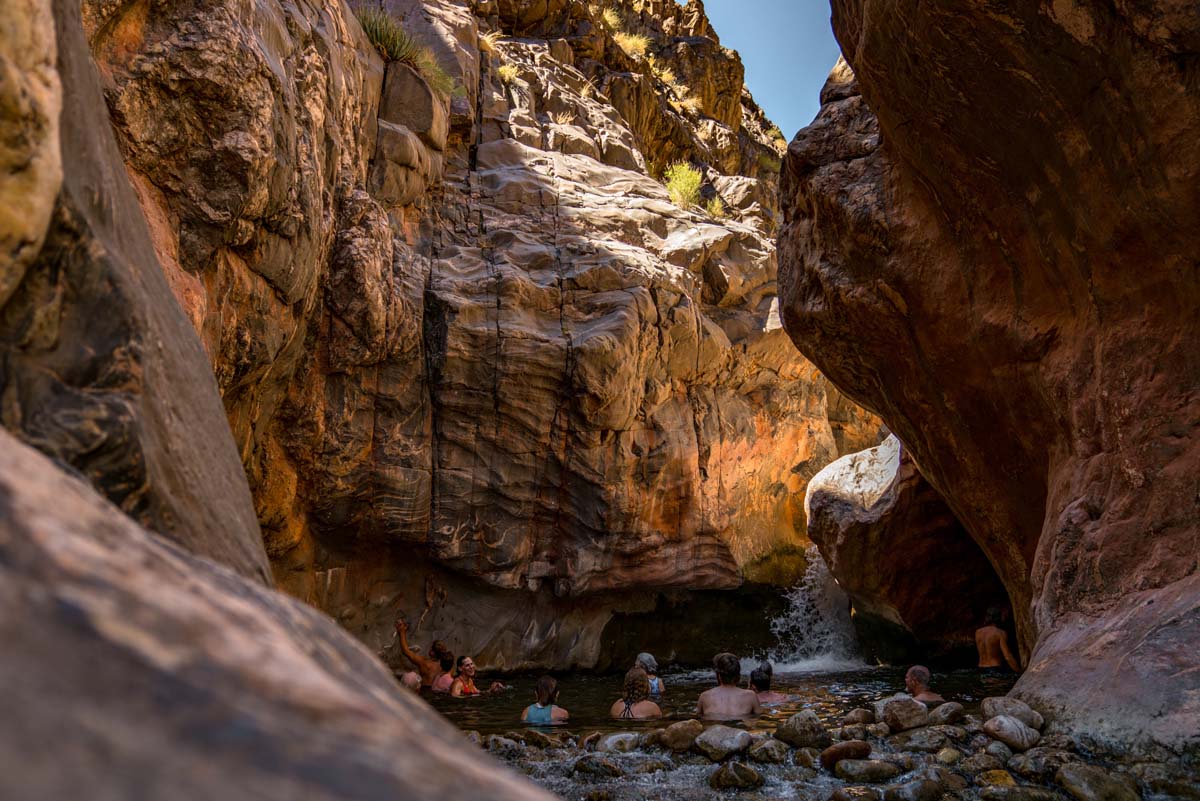
I was surprised not only at the amount of side-hiking and physical activity we got daily, but by how many springs, waterfalls and swimming holes are located on either side of the river. The short hike to this waterfall and pool led to chicken fighting and ultimate relaxation.
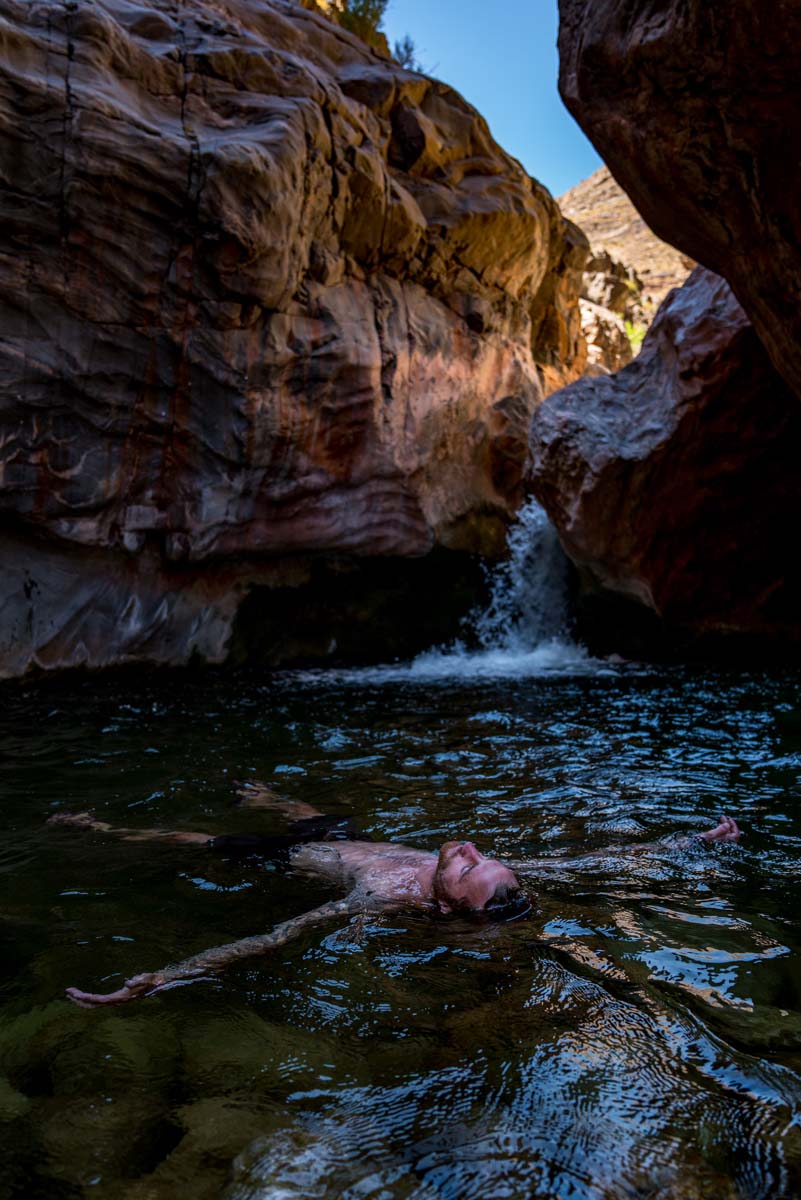



Havasu Falls is a sought-after destination. We planned to arrive extra early so we could have it all to ourselves.
From the river there is a trail to the falls, a route wading through turquoise waters of the slot canyon. From the rim, there is a ten-mile hike to reach the falls. The water at Havasu is turquoise because of calcium carbonate, a mineral found in the rocks.


We laughed with joy (and at our friend who had a hard time swimming through a deep part of the slot with a heavy current).

I’d never felt a relentless, dry heat like at the Grand Canyon. The winds blowing through the canyon felt like a hair dryer, forcefully expelling hot, dry air. The towering rock radiated scorching temperatures as the sun baked everything it touched.
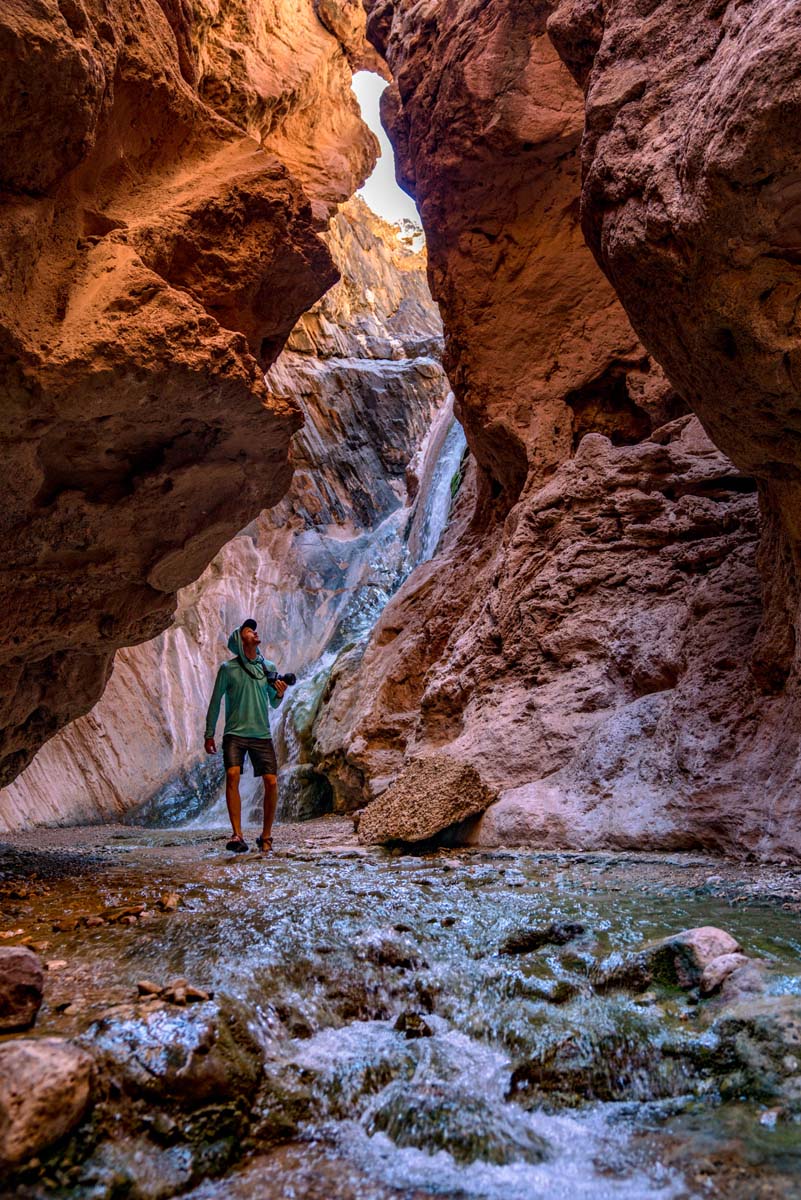
The shaded midday slot canyons and icy waters of their falls offered refuge and pure delight.

Long, calm stretches of water made for a few slow, low-mile days on the river.
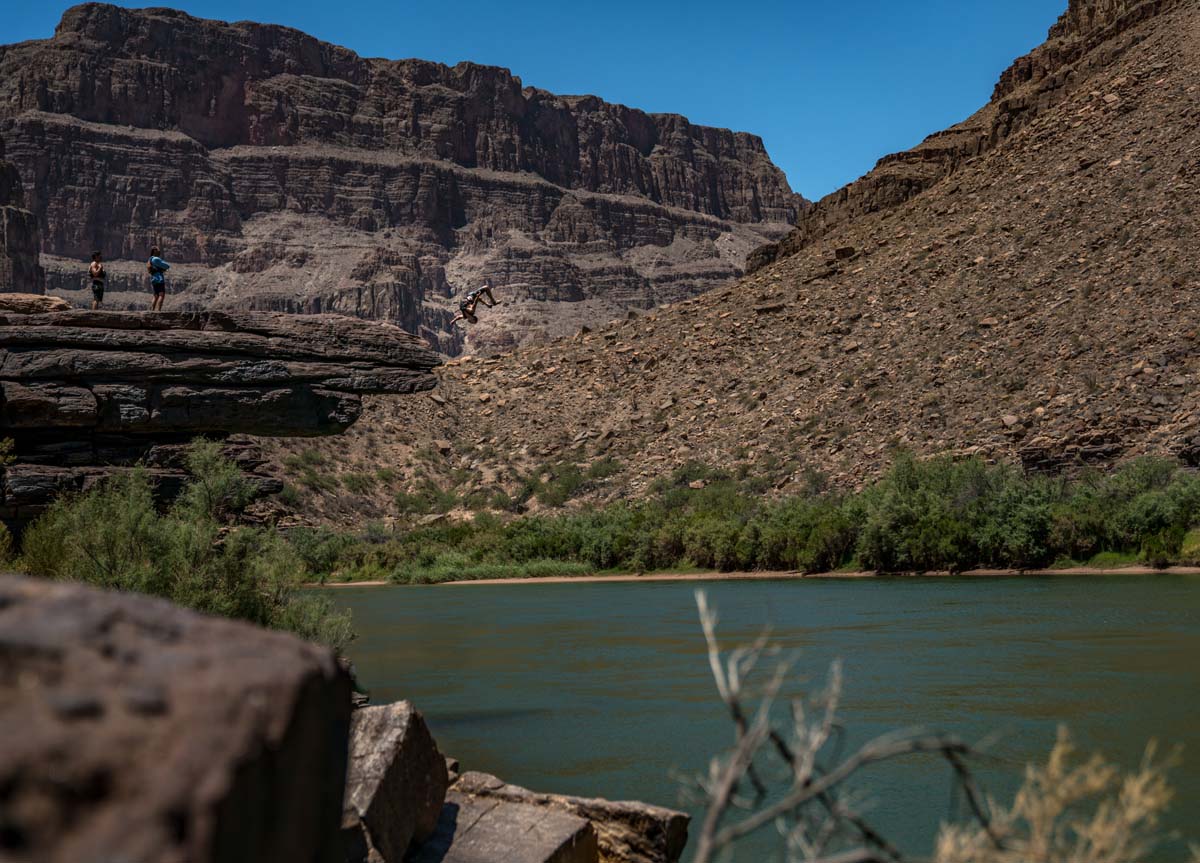

The Grand exposed me to various plants and insects I knew nothing about, but I quickly learned to be wary of their dangers.

One of those is the tarantula hawk, a wasp that supposedly has the most painful sting of any wasp in the world. It attacks tarantulas, paralyzing them with a sting before dragging them into a den. Here it lays an egg that hatches into a larva and devours the paralyzed spider alive—over the course of several weeks.
My first hike, I ran my hand through a beautiful, lush green plant as I walked by. I stopped in my tracks as the plant dug multiple thorns into various points in my hand. Ouch!

Rule of thumb: Don’t touch any of the plants out here—most aren’t friendly and will poke and snag skin.
The canyon walls rise so high that the sun would disappear around 4 or 5 p.m. some days. However, the light remained until 10 p.m., creating interesting hues and lighting.
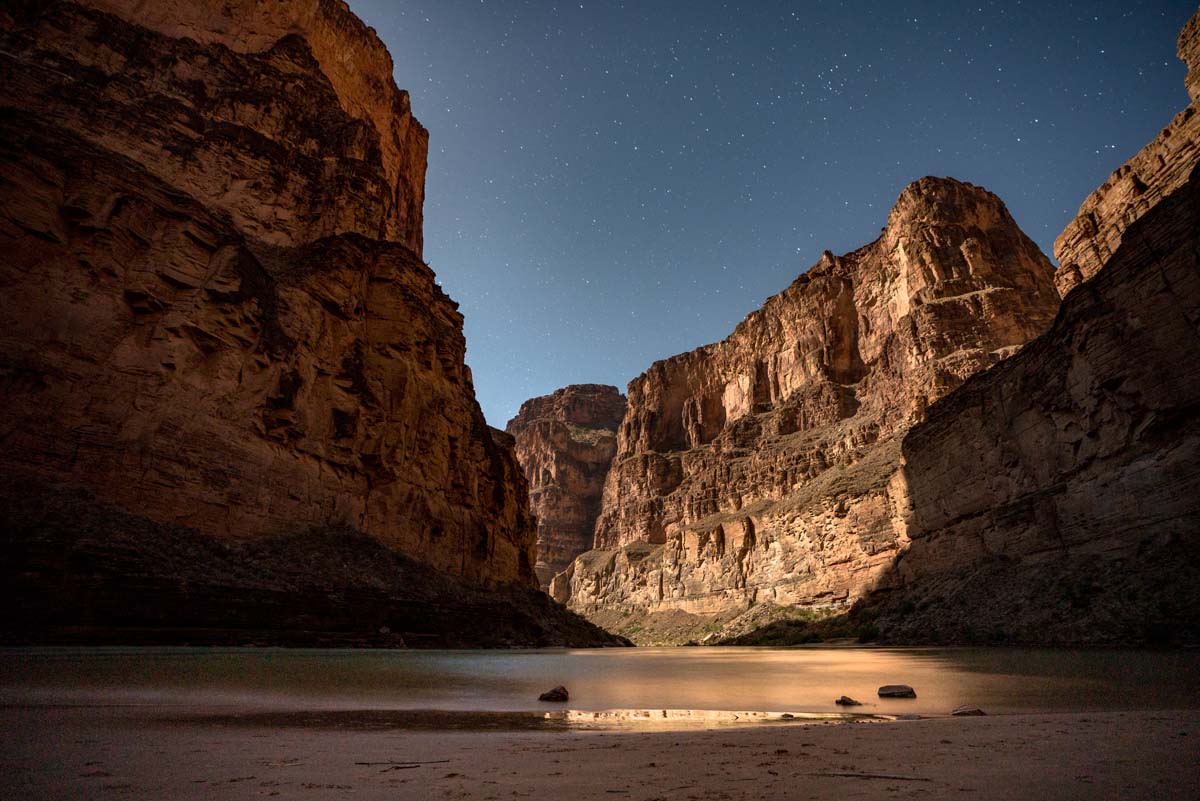
The rising and setting of the moon over the canyon was more dramatic from our perspective. The moonlight played on the walls, bouncing off surfaces and constantly casting shape-shifting shadows as the moon changed position in the sky.
All in all, beers, laughs, games, shenanigans, introspection and solid bonding went down in the sprawling, wild landscape of the Grand Canyon.

We overcame Lava Falls together, the biggest rapid in the Grand (class 10), and one of the most revered whitewater runs in the United States. Fortunately, a wooden oar that snapped in half on that run was our only loss.

Exactly 192 miles after meeting the group at their half-way point, we parted ways where the Colorado River converges into Lake Mead. At the take-out point, we de-rigged, said our goodbyes and headed our separate ways—all of us happier, more fulfilled and changed for the better.
All Photos by Jo Savage.
from Men's Journal https://ift.tt/2zK3G4L
7 Shirts to Make You Look and Feel Cool as Hell Boating, Kayaking, and Fishing
An early spring and already-scorching temps out West means one thing: river season is officially upon us. And just in time, considering we’re all seriously itching to let loose after two-plus months of lockdown. Whether you’re rafting, kayaking, SUPing, or even just fishing, an easy afternoon on the water socially distanced from your nearest and dearest is cause for celebration. Besides your boat and cooler, you should invest in lightweight shirts.
Sure, there are a lot of tops that can keep the sun off your skin while you paddle or fish. But we suggest breathable, quick-dry, wildly patterned shirts to stay cool and dry. They’ll bring a smile to passersby’s faces and reflect the pure stoke that fills your heart as you’re carried by the current on a sunny afternoon.
Admit it: Plaid just doesn’t have that power.
So go on, ditch your basic sunshirt and flex a little river steeze. Here are seven options to get you started.
7 Lightweight Shirts to Keep You Cool and Dry on the Water
1. Helms x Howler H Bar B Snapshirt (above)
Austin-based Howler Brothers are perfectly cross-breeding the classic Western snapshirt with quality riverwear. This pearl-snap button-up has a classy, masculine fit but is made from a quick-drying, wrinkle-resistant cotton blend. We love their thoughtful details, like the lazy day illustrations and microfiber at the hem for an easy sunglass clean.
[$69; howlerbros.com]
Get itfrom Men's Journal https://ift.tt/2XcjW7A
'Locked in Hellsend': Not Your Average South African Quarantine
Although the pandemic has put nearly everything (including racing in Europe) on hold, the Trails Crew locked in Hellsend compound in Stellenbosch, South Africa have still been able to do what they love. Namely, throwing around dirt and wheeled vehicles.
Filmed and edited by Thomas Sandell
Additional filming: Justin Novella, Duran Van Eeden, Ryan Franklin, Theo Erlangsen.
Logo designed by: Justin Novella
Title Animation: Duran Van Eeden
This article originally appeared on Bikemag.com and was republished with permission.
from Men's Journal https://ift.tt/3cebg4X
Wild Turkey Remasters an Idea From the Archives With the Next Master’s Keep Bourbon
Wild Turkey is once again reaching into the archives to create something new with this year’s 17-year-old, bottled-in-bond release of Master’s Keep. This is not the first time Wild Turkey has hit the archives for inspiration. Master’s Keep (which started in 2015) has been a showcase for innovation, with a hint of nostalgia. This year’s Master’s Keep “Bottled in Bond” is a new take on a bottle released in 2007: Wild Turkey American Spirit.
American Spirit was a 15-year-old Bottled-in-Bond bourbon, released at a time when a 15-year-old Bottled-in-Bond bourbon was only getting a fraction of the attention it deserved—before the bourbon boom changed the bourbon world entirely.
Master’s Keep has been the host for pet projects from master distiller Eddie Russell—for instance, the sherry-finished Master’s Keep Revival, which was formulated in honor of a now-discontinued sherry bourbon his father Jimmy Russell oversaw the release of.
Other entries in the Master’s Keep series have included Decades (a blend of whiskeys from 10-20 years of age) and Cornerstone Rye, which is the line’s only rye release to date.
This year’s bottling is special for both its age and its labeling. The term “Bottled in Bond” (colloquially, BIB for short) is a labeling designation with a lot of requirements—sort of like “champagne,” or “extra-virgin.” Any bottle displaying the BIB designation must be composed entirely of liquid distilled in one “distillation season” (there are two distillation seasons, January–June and July–December). That means everything in the bottle went into a barrel within six months. The liquid in that bottle must also be a minimum of four years old, and have aged entirely in a federally bonded warehouse.

Samples of the new batch haven’t been shared with the public yet, but official tasting notes from Wild Turkey say the bourbon has “an enticing taste and aroma of toasted oak, apple and dark cherry highlighted by the sweet confectionary flavors of vanilla, brown sugar and toffee. The enjoyable, lingering finish is complete with dark notes of mocha, smoke and spice.”
Master’s Keep Bottled in Bond will include only about 14,400 bottles of total production, and should retail for around $175 when it goes on sale in June. Track it (and the other bottles in the Master’s Keep line) down here.
Get itfrom Men's Journal https://ift.tt/3exxVdY
You Can Still Go Skiing at These U.S. Ski Resorts
With warming temperatures and receding snowlines, many skiers are stowing their gear for the season. Sure, there’s tacky singletrack to ride and surf to catch, but as states ease their coronavirus restrictions, there are still a few chairs left to ride.
Here’s a list of open resorts in the United States:
Arapahoe Basin reopened their lifts on May 27 to skiers. They’re operating on a day-by-day reservation system and will remain open as long as conditions permit.
Crystal Mountain will open June 1, and run for two weeks with daily reservations.
Timberline Lodge on Oregon’s Mount Hood reopened for the summer season, and ski camps will run in the resort during the summer season. The Palmer glacier lift is closed until it can be repaired—it sustained severe ice damage in a storm.
Oregon’s Mount Bachelor reopened their lifts for two weeks, and have now closed them again for the season. Uphill traffic is allowed as of May 25.
Beartooth Basin on the Wyoming-Montana border will open June 1 and stay open through July 5, conditions permitting.
Snowbird decided it will not reopen, but opened its slopes to uphill traffic.
Each of these resorts has stringent social distancing restrictions that are unique to the resort, so read the guidelines on their websites before you book your reservation.
This article originally appeared on Powder.com and was republished with permission.
from Men's Journal https://ift.tt/2XHAXpl
Behind the Making of Greg Daniels' New Netflix Show 'Space Force'
GREG DANIELS ISN’T happy with the last syllable of “Kokomo.” For the past hour, the 56-year-old TV writer and showrunner has been sitting in an editing room at Universal Studios, outfitted with a video screen, soundboard, and foosball table no one has touched. Dressed in a plaid shirt and dark pants and flanked by a half dozen producers and executives, Daniels is critiquing the first episode of Space Force, a Netflix comedy out in May about a new branch of the Armed Forces. He created the show with the actor Steve Carell, who plays Mark R. Naird, a tightly wound and uber-patriotic general.
In TV, most sound is added in post-production, affording showrunners like Daniels, the creative visionary behind such unfuckwithable sitcoms as The Office and Parks and Recreation, the power to tweak endlessly. Two sound engineers, stationed at mixing consoles, keep replaying snippets of the show on a screen at his command.
Space Force follows Carell’s General Naird as he tries to launch the new, titular military branch and return astronauts to the moon. He quickly gets sidetracked by his doddering dad (Fred Willard) and his wife and daughter, whom he must uproot for his new gig. Then there are his co-workers. Dr. Adrian Mallory (John Malkovich), a “civilian scientist,” proves especially grating, with his knack for summoning scientific data that runs counter to whatever Naird wants to do.
For Daniels, the problem with “Kokomo,” the 1988 coconut-scented Beach Boys hit, is not the song itself, which Naird sings along with in a pivotal scene, but the way the last syllable is isolated and drenched in reverb. “I feel like the last sound of oh on Kokomo gets clipped,” Daniels says. “I feel like that was Kokomah.”
The engineers replay the part, and voila, there it is—a slight ah vowel sound at the end. Daniels’ longtime executive producer, Howard Klein, is in a swivel chair. “Wait,” he says, spinning toward Daniels, “is it bugging you that you can’t hear the oh? Because I actually like it.”
“It’s just bugging me,” Daniels says. “Can we just hear the oh inside of the reverb? I want to hear that oh.”
If this detail seems extraordinarily minor—it is. But you have to understand that Daniels and his team have been working on this episode for more than a year. I repeat: a single half-hour of television, 365-plus days of effort. There’s serious and understandable pressure to get everything exactly right: Space Force marks the first time that Daniels and Carell have worked together since The Office, NBC’s beloved and long-running faux docuseries about a Pennsylvania paper company. Launched in 2005, the show turned Carell into a bona fide star in his turn as cringe-machine-cum-boss Michael Scott and cemented Daniels as a sitcom savant.
Now, with Space Force, Netflix is hoping and praying that a Daniels-Carell reunion can replicate The Office’s magic and spark a bingeing frenzy. Because Netflix has a Very Big Problem: The Office, its most-popular licensed program, is leaving the platform at the end of 2020 (as is Parks and Rec, its third most-watched). Last year, NBC outbid Netflix for the broadcast rights, agreeing to pay Universal Television $500 million over five years to bring the show to its own streaming service. Netflix needs a juggernaut to fill the void and is reportedly shelling out $1 million per episode to Carell in its efforts.
For episode one, the trouble is that “now we only have five hours to get the sound right, which is 50 percent of the experience,” explains Daniels (who, as the showrunner, is no doubt making out OK, too). The Nashville orchestra that’s supplying original music for the show hasn’t even sent over recordings yet. Fortunately, Daniels is one of those mutant humans who convert stress into a high-octane fuel. A subtle tension runs beneath his reedy tenor voice at all times, and his back remains taut as he bends over his notepad.
Despite the crunch he’s under, one suspects that he’s like this 98 percent of the time anyway. Maybe it’s the native New Yorker in him: He walks with an unmistakable ready-to-push-through-Penn-Station-at-rush-hour forward tilt. Yet he gives notes in a remarkably casual tone, and he laughs at himself when he can’t decipher his scribbled handwriting. In writers’ rooms, he has been known to lie on the floor and eat peanut-butter sandwiches while mulling problems.
The “Kokomo” scene currently absorbing his attention is quintessential Daniels: to co-opt a cheesy or forgotten scrap of American culture for emotional catharses—like when Dwight Schrute, slumped in a car post-breakup, blares R.E.M.’s “Everybody Hurts.” In this case, General Naird, who seems to subsist entirely on salutes and black coffee, turns to the Beach Boys for comfort in a moment of uncertainty, and he feels “Kokomo,” by God.
DANIELS HAS SPENT his life perfecting the creation of TV moments such as this. The son of an ABC Radio executive and a New York Public Library manager, he grew up reading humorists such as S. J. Perelman. In college, he landed his first comedy-writing gig at The Harvard Lampoon, where his classmate, and future roommate, Conan O’Brien also worked. Both went on to write for Saturday Night Live and The Simpsons. Daniels met his wife, Susanne Daniels, currently YouTube’s global head of original content, in the lobby of the former. “Greg is smart enough to be running some business where he’s not paying taxes and destroying society with expensive pharmaceutical goods,” says Nick Offerman (Parks and Rec’s Ron Swanson). “That he instead uses his wizardry to make us laugh and to think about decency makes me feel very grateful.”
Each series Daniels has co-created and helmed—The Office, King of the Hill, Parks and Rec—has been proudly provincial, in setting and temperament. He revels in bucolic quirkiness. Take Li’l Sebastian, the tiny horse in Parks and Rec that Leslie Knope (Amy Poehler) proudly proclaims was once “the eighth most photographed object in America!” “Real life and ordinary people are very interesting and important,” he tells me during an editing break, while eating Thai food in a tiny conference room. “And 99.9 percent of Hollywood is not that.”
With Space Force, Daniels has set his sights on perhaps his most Americana of subjects: space. “There’s something so all-American and positive about NASA,” he says. “Our greatest moment as a society was putting a man on the moon.” He aimed to incorporate that sense of unity and optimism in Space Force, to ensure that it has “a nice, noble spine.”
“That Greg uses his wizardry to make us laugh, instead of destroying society, makes me grateful.”
Though Daniels created and developed Space Force, the idea for it originated not with him but from within Netflix, after President Trump began proposing the new military branch in 2017. Netflix first broached the idea with Carell, who expressed interest in coming aboard if Daniels would, too. Out of the blue, “I basically got a call,” Daniels says. At the time, there was no premise, no characters, no plot—just a name: Space Force. For Daniels, the prospect of filling in the blanks was exciting, and the ideas came quickly once he got to work.
The show will launch in tandem with the real U.S. Space Force, which Trump signed into law last year, ostensibly to gather intelligence and protect military assets. In January, Space Force the show tweeted out a photo of its fictional fatigues, patterned to resemble a lunar landscape. Which, Daniels points out, “is kind of ridiculous.” What do you need camouflage for on the moon? “And then,” Daniels adds, eyes filling with excitement, “the actual Space Force came out with their own camouflage—and it’s jungle, which is even more ridiculous.”
For all the pleasures of riffing on such absurdities, Daniels doesn’t intend to make pointed political statements with the show. He appreciates how the Armed Forces ensure that people are cared for and protected, and assures “the treatment of the military on the show is respectful.”
BACK IN THE edit bay, Daniels doesn’t let up on his notes after “Kokomo.” At various points this morning, he asks for more clinks in a gym scene, questions the squeakiness of Carell’s shoes in another, and ponders the filling of a water glass (“should it be faucet on, sip taken, drink down?”) and the whoop-whoop-whoop of helicopter blades (“slow them down?”).
Daniels developed his instincts for such minutiae in the network-sitcom trenches. He’s glad to be jumping into the streaming era now. Netflix has been extra supportive and unafraid to try new ideas, he says. But launching a new show is nerve-racking all the same, especially given the changes TV has undergone. When The Office launched 15 years ago, it was singular on broadcast TV—odd, unflinching, politically incorrect, yet undeniably human. Still, it was a product of the old-school TV machine. And with streaming still nascent, required viewers to tune in each week to watch, which often lent to a strong sense of investment.
Further to The Office’s benefit, it enjoyed 22-plus-episode season orders, whereas Space Force, like many other new comedies, got greenlit for 10. Daniels explains that, with fewer episodes per season, shows can struggle to form deep connections with viewers, who, inundated with content, can easily binge and forget about a series in a weekend.
The Office also resonated with audiences in a way that can’t be engineered and certainly wasn’t expected. The show’s lasting relevance is “shocking, in a great way,” Carell tells me. “The more I get asked about it, the less I know. It’s just a happy little miracle that people found it.” In separate conversations, Daniels and Carell each insist that it’s a joy to be making a series together again, not a pressure cooker. Daniels, for one, tries to ignore outside expectations by focusing on Space Force’s details to an exacting degree, as he has today in the edit bay.
The pressures on him aren’t limited to TV. He and his wife have four children, and balancing a demanding job with family life requires constant negotiation. For a time, Daniels was showrunning both Parks and Rec and The Office, which meant that he had to lock “every script, every cut, everything” for 50 episodes of TV. During this time, he saw an old interview with Yasser Arafat, in which the Palestinian leader said that he tried to spend 30 minutes a day with his children. “I was like, Ah, shit,” Daniels recalls. “As a dad, I’m not doing as well as Yasser Arafat.”
Nowadays, Daniels tries to take one day off a weekend to hang with his daughter who’s in fifth grade. (His other three children are either in college or in the working world.) Because he works so much, household chores do tend to back up. His shower has been broken for more than six months, and he hasn’t found the time to fix it yet. “I have to take baths,” he says. Not that he totally minds: “That’s been my thing. I’ll take a bath and read.” If his shower wasn’t broken, who knows if he’d make time to relax.
In the conference room, Daniels says that, of all the characters he’s created, he “relates heavily” to Dwight Schrute, the paper salesman on The Office who keeps survival tools within reach. Daniels always thinks several steps ahead, trying to anticipate what could go wrong and to figure out solutions. More recently, though, he’s felt a close kinship with General Naird, who’s constantly putting out fires at home and the office. In the scene when Naird sings “Kokomo,” he does so to reassure himself that everything is going to be OK. Yet, dancing by himself, he’s as rigid as ever. It’s an endearing moment: An everyday man who can’t relax, trying to keep himself together in hopes of pulling off something improbable and grand.
from Men's Journal https://ift.tt/36Epif6
Here's How You Can Make Pizza In A Mug From Scratch, Under 5 Minutes
from NDTV Food - Latest https://ift.tt/2Xe8Dfm
Indian Cooking Tips: How To Make Mughlai Chicken Pulao At Home
from NDTV Food - Latest https://ift.tt/2MbXllu
5 Foods To Help Reduce Period Pain By Celeb Nutritionist Rujuta Diwekar
from NDTV Food - Latest https://ift.tt/3dqpxg8
Protein-Rich Diet: Potatoes (Aloo) May Provide High-Quality Proteins For Weight Loss And Muscles
from NDTV Food - Latest https://ift.tt/3cl7fMl
Lockdown Cooking: Amp Up A Simple Egg Curry With This DHABA Restaurant Special Recipe
from NDTV Food - Latest https://ift.tt/3evQFdS
Five Spice Powder: How To Make The Sweet-And-Spicy Seasoning For An Authentic Chinese Cuisine
from NDTV Food - Latest https://ift.tt/2TQEQXN
McDonald's Or KFC? TikTok Video Combined Both To Make McZinger Burger; Internet Is Impressed
from NDTV Food - Latest https://ift.tt/2XDSZJb
Easy Recipes: 5 Light And Delightful Rice Meals For Summer
from NDTV Food - Latest https://ift.tt/2Ahjs7e
Want To Make Stale Bread Fresh Again? This Facebook User's Hack Is A Game-Changer
from NDTV Food - Latest https://ift.tt/2XfAQ5w
This Restaurant-Style Paneer Changezi Is The Best Paneer Recipe You'll Make In Lockdown
from NDTV Food - Latest https://ift.tt/36KfhNA
Indian Cooking Tips: Give Your Classic Samosa A Healthy Spin By Baking It (Recipe Inside)
from NDTV Food - Latest https://ift.tt/2zJsUAh
Slurp Alert: This 3-Ingredient Mango Lassi Ice-Cream Screams Summer
from NDTV Food - Latest https://ift.tt/36GnF0e
Drinking Coffee May Promote Better Digestion, Aid Digestive Disorder - Study
from NDTV Food - Latest https://ift.tt/2XcDPvr
Karisma Kapoor Just Revealed Her Favourite Fruit; Guess What It Is
from NDTV Food - Latest https://ift.tt/36Egt4M
Thursday, 28 May 2020
Protein Rich Sunbutter Bar Treats
Protein Rich Sunbutter Bar Treats
“I CANT BELIEVE I ATE THAT” That’s a conversation I never want you to have with yourself ever again….
You see, so many tend to look at food as “good” or “bad” which sets you up for “failure” and being disappointed with yourself.
Here is what I teach my clients and what I use for myself.
FOOD itself is neutral. Your choice and intentions around food can shift.
I never ask myself “is this good or bad” I instead ask:
What will this food DO for me? Are their nutrients in it? Was it once alive and thriving? Is it made with simple nourishing ingredients? And MOST importantly, what am I looking for right now. Like will it bring me energy, nourishment, heal me? Will it fill me up? Will it bring me ENJOYMENT having it (uhhh yeah you are allowed to enjoy your food) and HOW WILL I FEEL AFTER EATING IT.
For example a large pizza and Reece’s peanut butter cups will give me enjoyment in a moment but uh, afterwards not so much!
Change your conversation around food and ask yourself better questions but stop labeling food as GOOD or BAD…
And btw you can have ALL the things I listed (energy, nourishment, enjoyment, healing etc… with home made treats like this too!)
GET IN MY BELLY! These protein rich, healthy treats are so good! ESPECIALLY when I make with my favorite Protein Rich Sunbutter Bar Treats
Here are the Ingredients to Gather!
1 cup Sunbutter
1 cup coconut flour
1 cup almond flour
1/2 cup coconut sugar
1/2 tsp cinnamon
1/2 cup almond milk or other nut milk
1 pkg chocolate chips (vegan or healthy version if you can find one)
Directions
1. Mix coconut flour, almond flour, coconut sugar, and cinnamon in a medium brown until blended.
2. Stir in the Sunbutter until well incorporated, batter will be crumbly.
3. Add almond milk 1-2 tbsps at a time until a dense batter is formed.
4. Press into a 9×9 glass pan
5. Melt the chocolate chips, and pour over the top and spread it out until it is even.
6. Refrigerate for at least two hours before serving.
ENJOY! Do not forget to share!
XO,
Natalie Jill
Want additional sunbutter recipes:
Find them:
Sunbutter Grass Hopper Cookies
Chocolate SunButter Donuts – Gluten Free and Dairy free
Aging In Reverse Super Food Smoothie
The post Protein Rich Sunbutter Bar Treats appeared first on Natalie Jill Fitness.
from Natalie Jill Fitness https://ift.tt/3dcA3b3